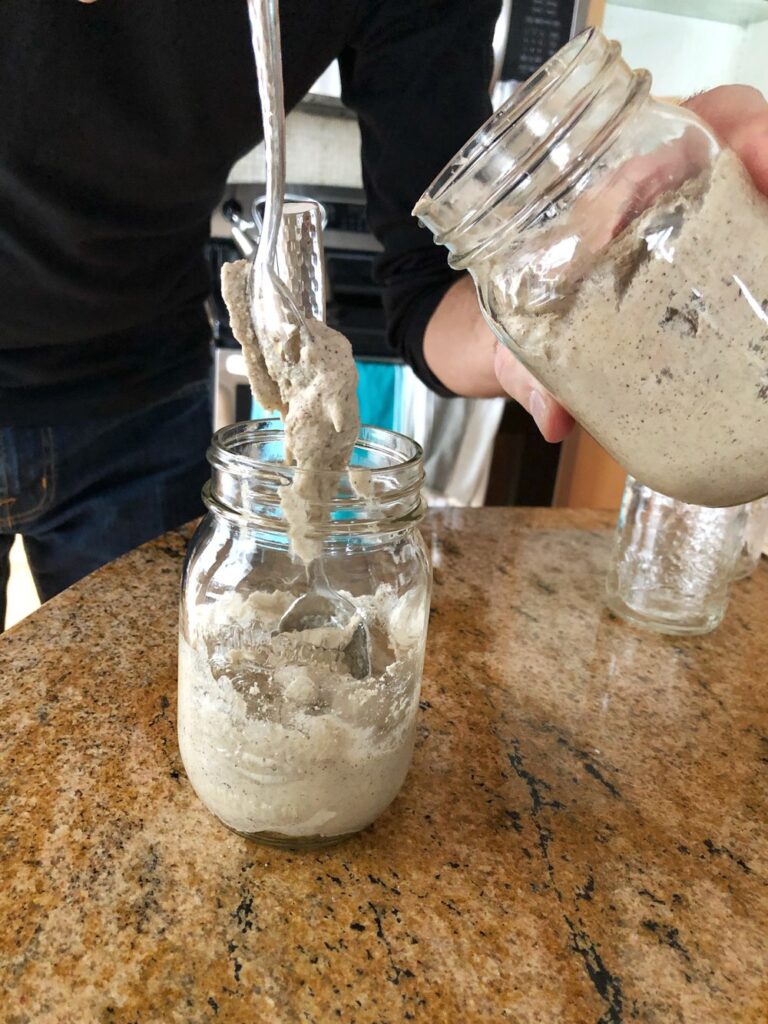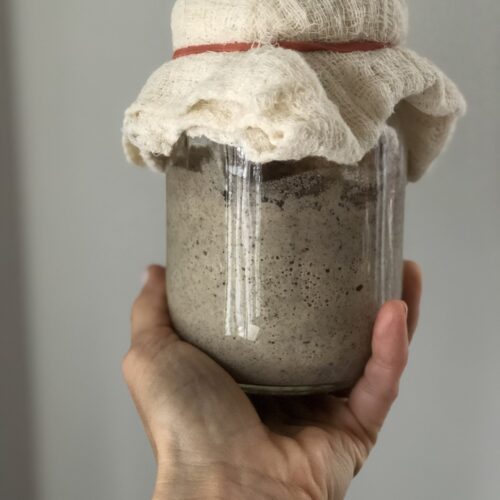Sourdough Starter by My Mister (Rick Morton)
A sourdough starter is basically a fermented flour mixture that will eventually be used as a levian when you make a loaf of bread. It replaces the yeast used in many bread recipes.
A happy, active, and bubbly Rusty
With yeasted bread you buy the yeast and add it to some warm liquid (perhaps milk & water) to wake it up and you mix in a bit of sugar so it has something to eat. The byproduct of the yeast eating the sugar is gaseous and that is what makes the bread rise and have little air holes. With a sourdough bread you ferment flour and the bacteria created during the fermentation process is like a natural yeast. Some might think of their starter as a flatulent teenager … you feed it sugar and flour and it grows and gets gassy 🙂

From a practical standpoint, the big difference between yeast and a sourdough starter is that it takes time for the flour to ferment and you have to tend to the mixture until it becomes active. To create the starter you mix flour and some filtered water in a jar, cover it with a porous material (I use cheesecloth at home but at work we use plastic wrap), then you put it in a place where the temperature is relatively stable and relatively warm (between 20 degC and 27 degC). You must use filtered water since chlorine in tap water kills the bacteria that makes the mixture active and creates the bubbles. The temperature of the ingredients is important … all of them should be in the low to mid twenties (between 20 degC and 27degC). The cover that you put over the jar needs to allow gas to escape so don’t wrap it too tightly if you are using plastic wrap.
Once the starter is created, it needs to be maintained until it becomes active. Every twelve hours or so you create a new starter and then take half of the previous starter and mix them together. Then cover it and leave it on the counter until the next “feeding”. The other half must be tossed in the organic waste bin 🙁
You need to keep feeding the starter until it starts to become active and bubbly. This could take anywhere from 3 days to ten days depending on the temperature on your counter. If it is relatively cool then it will take longer and if it is pretty warm then it will happen faster. It’s important that the temperature doesn’t fluctuate too rapidly during this initial growth period.
Once the starter is active and you can see bubbles through the side of your container (I use straight sided mason jars so I can see the activity), you can use it to make some bread (recipe coming soon).


subscribe to my mailing list to get the latest recipes, promo codes to my favourite brands and more!
Join my mailing list and be the first to get my recipes, discounts to brands I love and more! I promise not to spam you.
3 Responses
Hi Teriann, im loving your recipes! How do you feed the starter weekly?
I’m so glad you’re loving my recipes! I actually am going to be revamping this Sourdough Starter and I would love to give you my most current response. Please hang tight in the meantime; in regards to this recipe I used to feed the starter with 1 cup of superfine brown rice flour and 3/4 cup plus 2 tbsp room temperature filtered water and whisk until smooth. Then I would transfer the starter into a clean glass jar with an airtight lid, then set aside, uncovered, at room temperature for 4-5 hours or until bubbly. Once the starter bubbles up again, seal the jar and return it to the fridge until you want to use it again. I hope this helps!